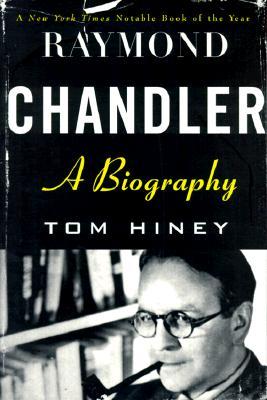The recent death of Robert Mitchum reminds us not only of his appearance in one of the best film noirs. Out of the Past, but of his impersonation of the detective Philip Marlowe in the remake of Farewell, My Lovely and The Big Sleep. Mitchum once claimed that, in his early days, he tended bar for Raymond Chandler himself.
At times, that must have been a big job. Tom Hiney has recounted in this, the newest biography of the man, how Raymond Chandler destroyed himself with alcohol. His literary peers (and juniors), such as Fitzgerald, Hemingway, and Faulkner, knew something about that themselves. But self-destruction and obsessive abuse did not make Chandler famous, even if he is known for them now. It is not Tom Hiney’s fault that Chandler’s follies darken and dominate his pages—that really was Chandler’s doing. Indeed, this biographer knows well that a successful writer is one who can put the best part of himself into words—and that Chandler memorably did.
Consider the ironic proof. As Hiney has noted, a volume entitled In Search of Literary Los Angeles (1991), disposing of Chandler in two paragraphs, dismisses him as “a misanthrope and a bigot,” which seems a remarkable way to treat the author who virtually created literary Los Angeles. In a similar spirit, Joyce Carol Gates has remarked upon Chandler’s racism and misogyny, which some may find as comforting as I do. Such deprecations, in a context that classifies Hawthorne as an oppressor and Melville as a wife-beater, are as perversely welcome as they are obtuse. Tom Hiney has shown how, in context, Chandler was no advocate of any white-male utopia.
Frank MacShane’s Life of Raymond Chandler, an excellent book, was published over 20 years ago. The London-based journalist Hiney has brought two particular credentials to the job of taking a second look: one is his British background, and the other, oddly enough, is his youth. The result is a striking and effective book.
Since MacShane did his work on Chandler, which also included editing the letters and notebooks, the reputation of his subject has continued to grow. Chandler is everywhere. Chandlerism seems a way of looking at the world, one that is continually revived. We are familiar now with female Philip Marlowes, and with black ones. Not long ago, Chandler’s stories were broadcast on cable. Chinatown and even Blade Runner were paraphrases of Chandler. Robert B. Parker has written “continuations” of Chandler—explicitly as well as implicitly—in his Spenser series. Even if we could evade the continual playback of Chandler’s screenplays and of the films made from his novels, there would still be the ineffable and inevitable Dead Men Don’t Wear Plaid. But escaping the mass media by picking up art novels would not efface Chandlerism, for necessary books like Walker Percy’s Lancelot and Gilbert Sorrentino’s Mulligan Stew announce an imaginative dependence on Raymond Chandler that is widespread.
Now that Chandler has been published by the Library of America, however, nonsense may perhaps be set aside. After all, his letters and this biography show Chandler to have been an old-fashioned liberal, as you might expect of a man born in 1888 and educated at a public school in England. When he came back to this country, he settled in Los Angeles. After time spent in the Canadian service in the Great War, he began to rise in the oil industry as America boomed in the 1920’s. Chandler was fired in the early 50’s for drinking and faced the crisis of his life. He determined to fulfill the dream of his youth by writing. The question then was, what to write and how to write it?
Chandler’s response was a modest one; he would undertake pulp fiction, stories of action and violence. And he would write for an audience and for money. Having cleared his mind of pretension, he could get on with the job. Eventually, he would meld all of the romantic yearnings and literary aspirations of his youth with a comprehensive grasp of the corruptions of urban life to produce novels that will not die. Tom Hiney has pointed out elements of Farewell, My Lovely, The Lady in the Lake, and The Little Sister that derive directly from true-crime stories, for the ultimate paradox of his melodramatic fiction is its firm hold on truth. Chandler has more in common with Balzac and Dickens than he does with his host of imitators.
Hiney’s book is flawed by errors in proofreading, among others. His summary of the plot of Farewell, My Lovely, for instance, gets whodunit and other things wrong. Even so, his biography of Chandler maintains its firm sense of perspective. He succeeds in showing us the Raymond Chandler who still lives in the imaginations of thousands of readers—the Chandler who knew that imperishable writing “glows with its own heat,” and was capable of delivering the same.
[Raymond Chandler: A Biography, by Tom Hiney (New York: Atlantic Monthly Press) 356 pp., $26.00]

Leave a Reply